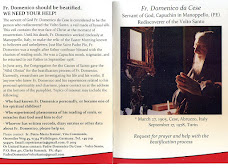

by Paul Badde
from the official publication of the Shrine of the Holy Face of Manoppello
Il Volto Santo di Manoppello, Dec. 2009 edition (Anno XCV #2) my translation of part one
"My heart almost stopped" is how Secondo Pia described the moment on a night in May 1898 when he withdrew the 50 x 60 centimeters photographic plate with the image of the Holy Shroud from the developing dish and held for the first time the face illuminated by the red light of the darkroom. Suddenly that image of a dead man appeared before him with all his wounds and the majesty of a king, appearing clearly to the observer, only in the image of a negative. "I almost let the plate fall to the floor. I feared breaking it in the sudden emotion of seeing before me the face of Jesus, as for 1900 years no one had ever seen. Two weeks later, in Genoa a newspaper had already spoken of the sensational discovery.
The history of the Shroud however had not begun with this discovery, because many before then were aware of what this cloth might have hidden within it. Before 1898 just in Western Europe alone there existed at least four churches purposefully dedicated to the cloth: Lirey, Saint Hipolyte, Chambery and Turin. In addition at Rome there was also a church where a copy of the image of Turin was preserved, the Church of the Holy Shroud on the Via del Sudario, close to the Basilica of San Andrea. Yet the first photo of the Shroud offered an incredible impulse to research. In effect on that night between the 28th and the 29th of May 1898 at Turin an incredible circle was closed, one that had begun to take shape in Jerusalem. And for this reason the beginning of the history of the Shroud is to be assigned to an environment without light.
There still exists the place of the origin of the cloth, even if Caliph Al Hakim had it destroyed and burned in 1009. But following that it was completely rebuilt according to its ancient structure. In it is the burial chamber of Christ in Jerusalem where every morning is read the Gospel of John, eyewitness of the resurrection of Christ from the dead.
For all of Christianity this represents the decisive point of the Gospel. It is absolutely unthinkable that John could have written in this part of the Gospel about affairs of little importance. In any case I had never heard any other passage proclaimed so many times as the first 8 verses of chapter 20 which I found translated in so many languages, the majority of which I didn't know. But it was not even a problem because I quickly learned the text by memory in those two years during which, as much as possible, I went there every morning. This happened during the years of the most recent intifada, when in that place there was solitude and tranquility as in a total paradise. This chamber drew me like a magnet. I could still draw it blindfolded: the low entrance, to the right the stone slab, beyond on the left side the passage way so tight that it is possible to cover only on one's knees or bent over. The Sepulcher of Christ was a narrow passage way on the left that led into the chamber where the deceased, wrapped in the cloth, was placed within the recess excavated along the right side. I still can hear in my ears the soft crackling of the candles placed in that room from which sprang for the whole world the first spark of the faith which announced Easter. Just by drawing ourselves closer to this moment, with the light of the dawn, the Gospel of John and the cloths, we can still distinctly hear today the crackling sound of that spark.
thanks to the author Paul Badde and to the Rector of the Shrine of the Holy Face of Manoppello, Fr. Carmine Cucinelli, O.F.M., Cap. for allowing and encouraging me to post this translation. In the days ahead I will be posting the rest of this article, along with other articles from the same edition of Il Volto Santo di Manoppello.





No comments:
Post a Comment